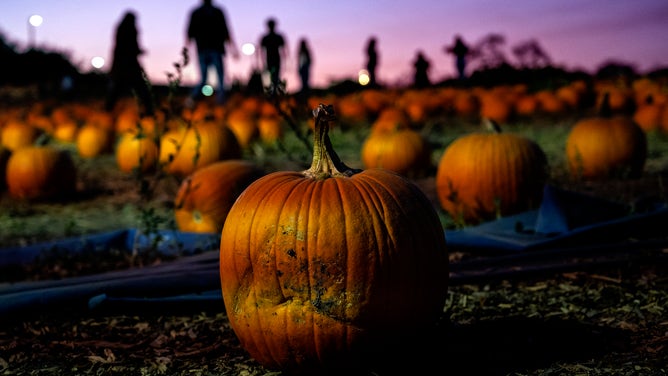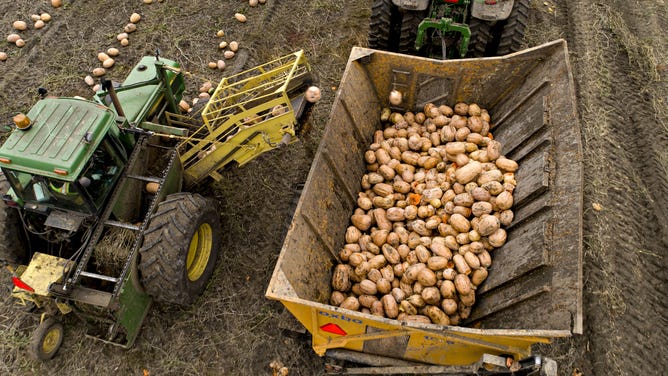Heat is enemy No. 1 to your jack-o'-lantern
Gourd protection tip: Keep your pumpkin covered and dry but don't spray it with bleach.

Thousands attend the 28th annual Cal Poly Pomona Pumpkin Fest in Pomona on Saturday, Oct. 2, 2021. The popular pumpkin patch features 30,000 Cal Poly-grown pumpkins for sale, farm demonstrations, live entertainment, food and a variety of activities at the campus AGRIscapes Center.
(Cindy Yamanaka/MediaNews Group/The Riverside Press-Enterprise via Getty Images)
Cooler temperatures mean it's time to visit your neighborhood pumpkin patch to snag the perfect giant orange gourd for a Halloween jack-o'-lantern, but what about states that don't have pumpkin-friendly weather?
Pumpkins grow faster in cooler and dry climates. Like Southern Hill Farms in Clermont, Florida, pumpkin patches rely on pumpkin brokers to get gourds from other states.
According to the U.S. Department of Agriculture, Illinois was No. 1 in 2019, harvesting twice as many pumpkins as any other state at 10,900 acres. According to the USDA, California, Indiana, Michigan and Virginia averaged between 4,700 and 5,600 acres in 2019.
While the seasonal fruit could grow in Florida because of the warmer, humid climate, Southern Hill Farms manager Kyle Hill said they likely wouldn't be big enough in time for the fall holidays.
The farm's fall festival draws people from around the state. The farm goes through truck-loads of pumpkins every year beginning in October, Hill said.
Unlike Florida's neighbors to the north, who begin seeing a cool down by early October, the Sunshine State's average humidity remains above 70% and temperatures in the 80s. Those conditions aren't friendly to a newly carved creation if you want to make it last until Oct. 31.
The best thing Hill said you could do to protect your gourd is keep it out of direct sunlight and out of the rain.
"Make sure that they stay in the shade, or they're covered, so dew doesn't form on them, or if the sprinklers come on at night, you move them out of the way, so they don't get wet," Hill said. "If they continue to get wet each night, whether they're in the shade or not, they will turn bad in probably a week or so."
Hill said he had kept uncarved pumpkins inside his home, and those have lasted up to a year with the aid of air conditioning.
LuAnn Duncan is an extension agent with the University of Florida IFAS, specializing in food safety and preservation.
She said while bringing your pumpkin inside is safe, don't put it in your refrigerator.
"I'm asking people, please don't put it in your refrigerator carrying it in and out. That's just a safety issue for me," she said.
Many articles claim to have the formula for keeping a jack-o'- lantern fresh by using bleach or even soaking it whole in cold water, but while bleach might help keep mold at bay, experts say the best thing to do is keep your gourd guarded.

Pumpkins grown for Nestle USA Inc. Libby's Pumpkin are harvested in this aerial photograph taken above Hartsburg, Illinois, U.S., on Oct. 27, 2017.
(Daniel Acker / Getty Images)
"Even through up in the 80s and things, it intensifies the growth of that bacteria, and so the recommendations there are saying things that will probably deter that growth," Duncan said.
To deter bacteria growth, lemon juice or vinegar would work just as well as Clorox, said Duncan, but then you might have a bug problem on your hands.
"One of the things they also recommend is doing things like Vaseline and spraying with WD 40 and all that kind of stuff, and I'm kind of like why?" Duncan said. "Because one of the things is, you can put this in your compost pile. You could do other things with it, you know, afterward."
If your pumpkin is covered in chemicals it needs to go in the trash, not the composite pile.
Southern Hill Farms sells a variety of pumpkins for the fall season, including Jumbo Jacks, heirlooms, gorgeous whites, and tiger stripes.
Another tip for helping to select a pumpkin that will have a better chance of survival is to give it a good look over before bringing it home.
"You should always flip over the pumpkin, look at the bottom side, see if it's soft or rotten because they typically will rot either where the sun faces them or on the bottom, where they get wet or anything," Hill said.
Hill said even an uncarved pumpkin shouldn't be subject to full sun on a hot day.